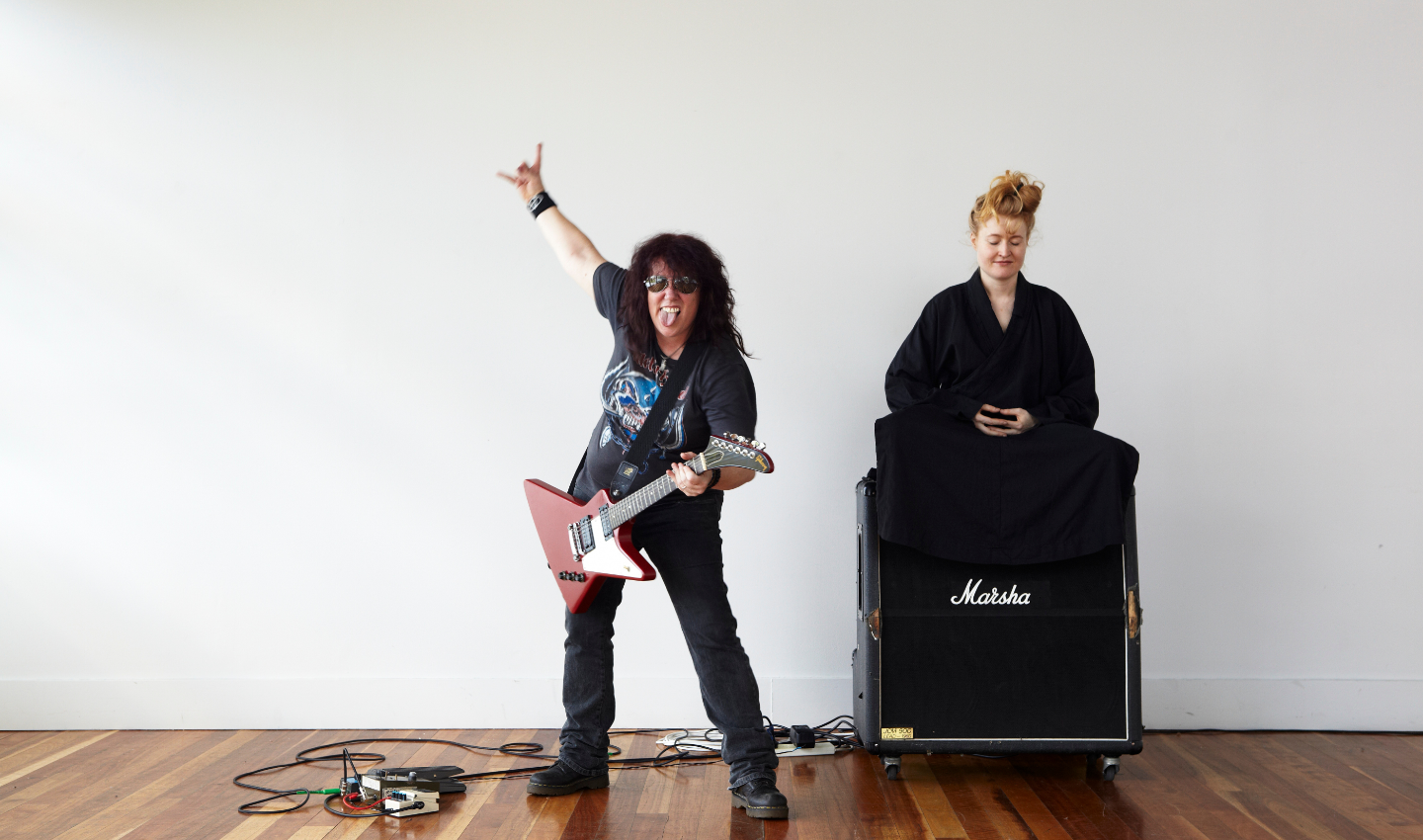QUIET/LOUD
Nell’s QUIET/LOUD (2012) is the first thing visitors see as they enter Greetings from Wollongong. Like the opening note of a frenzied set, it signals the show’s mood: party and play as forces inseparable from protest and politics. In this exhibition, joy is not a distraction from struggle — it’s part of the fight.
In the work, Nell teams up with Wollongong rock musician Bec Machine of Babymachine to stage a simple, striking proposition: one person sits perfectly still, the other shreds at full volume. Nell, in meditation mode atop an amplifier named “Marsha,” is QUIET; Bec, hammering her guitar, is LOUD. Shot on digital video in a single take, against a mise-en-scène of black-and-white neutrals, the video plays once forwards in a blast of heavy metal, then in reverse, the sound taking on a demonic turn.
It’s a set-up loaded with opposites: quiet/loud, stillness/action, forward/backwards, black/white. Even the amp is a joke on gender and fame — its “Marshall” brand name feminised (or queered?) to “Marsha,” a mononym like “Nell,” suggesting rock-star status that needs no surname. But Nell delights in flipping assumptions. Sitting still doesn’t always mean a clear mind — often it’s “monkey mind,” racing with shopping lists and the daily grind. By contrast, total immersion in action — making, doing, fully inhabiting the moment — can bring the purest mental stillness.
Feminism is built into the work’s DNA. Babymachine is an all-female band, its track “A Band Room of One’s Own” (from the LP Appetite for Reproduction, 2011) riffing on Virginia Woolf. The videography was by artist and post-punk musician Tina Havelock Stevens, with sound by Ingrid Rowell and stills by Zan Wimberley. It was an all-women production — a safe space where women commanded both the instruments and the camera.
QUIET/LOUD also dwells on the kinship between rock shows and spiritual practice. As a Buddhist, Nell knows the hard work of finding presence in meditation. But she’s also found it through live music: those moments when your body and soul dissolve into the crowd, when you leave a sweaty pub gig smiling and feel the world might be OK. She links it to choirs, chanting, and older tribal rituals. Belonging can be as simple as finding your people at a concert — sharing values, wearing the same T-shirts, plastering the same posters on your bedroom wall. Here, fandom itself becomes a politicised act of consciousness-raising.
Regional and class roots are embedded in the work. Nell grew up in Maitland near Newcastle, another steel city like Wollongong — blue-collar places where radio and Countdown offered the “clues” to becoming an artist. Her love of AC/DC is an instant giveaway of where she comes from: a signal of working-class authenticity over elite polish. Back then, you’d stay up late to tape clips on Rage — an experience of anticipation and focus that feels rare now. The media landscape has shifted; TikTok has eaten attention spans. “I think social media kind of ruined video art,” she says. Yet QUIET/LOUD endures, distilling her core themes — dualities, feminism, rock’n’roll, spirituality, regional pride — into video art dressed as music video, and vice versa.
Here in the gallery foyer, QUIET/LOUD doesn’t just welcome audiences. It primes them. It declares: this is an exhibition where the gig flyer is as political as the protest banner, where the mosh pit can feel like a movement, and where joy itself is a form of resistance — there’s buzz in the barricades. Loud in its quietness, quiet in its loudness, QUIET/LOUD declares that presence, place, and the state of being truly here can happen anywhere.
By Daniel Mudie Cunningham.
Image: Nell, QUIET/LOUD, 2012, collaboration with Bec Machine (Babymachine), single-channel digital video, Videography: Tina Havelock Stevens | Sound: Ingrid Rowell. Purchased 2024.

